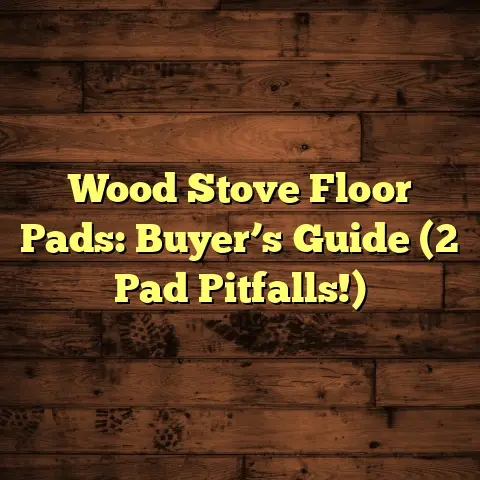How To Create A Checkerboard Tile Floor In Your Laundry Room? (Explained)
Creating a checkerboard tile floor in your laundry room is an exciting project that can breathe new life into a space often overlooked in terms of design. I remember my own laundry room transformation vividly—how a simple idea turned into a rewarding experience. Let me take you through the journey of planning, executing, and enjoying my checkerboard tile floor, filled with personal anecdotes, practical tips, and lessons learned along the way.
The Inspiration Behind the Project
I’ve always had a passion for home improvement projects. One rainy afternoon, while scrolling through design websites, I stumbled upon a stunning laundry room featuring a black and white checkerboard tile floor. Instantly, I was struck by how such a classic design could make a mundane space feel stylish and inviting. The idea took root in my mind, and I began envisioning my laundry room transformed into a chic, functional area.
Setting the Stage
Before I could start tearing up the old flooring, I needed to assess my current laundry room. It was small—just 12 feet by 8 feet—but it housed a washer, dryer, and some shelving. The existing vinyl flooring was worn out and didn’t match my aesthetic vision. I imagined something fresh and modern, yet timeless.
Now, let’s talk about planning. This step is crucial to any successful flooring project.
Planning Your Project
Measuring the Space
The first thing I did was measure the space accurately. I jotted down the dimensions: 12 feet by 8 feet meant I had a total area of 96 square feet to work with. Then, I took into account any obstacles such as plumbing fixtures and electrical outlets. Ensuring that my measurements were spot-on would save me headaches later during installation.
Choosing the Right Materials
Next up was selecting the materials. While browsing tile options at my local home improvement store, I found myself drawn to ceramic tiles. They’re durable, easy to clean, and perfect for the high-traffic area of a laundry room. For my checkerboard pattern, I decided on 12-inch tiles—half black and half white.
Cost Estimation with FloorTally
I used FloorTally to help estimate costs, which made budgeting a breeze. The platform allowed me to input the prices of the tiles and adhesive directly from local suppliers. The black tiles were about $2 each, while the white tiles were slightly more expensive at $2.50 each. For a total of 64 tiles (32 black and 32 white), the cost broke down as follows:
- Black Tiles: 32 x $2 = $64
- White Tiles: 32 x $2.50 = $80
- Total for Tiles: $144
FloorTally also helped me account for additional materials like adhesive and grout, keeping my budget in check.
Creating a Timeline
Once I had my materials ready and costs estimated, I set up a timeline for the project. I planned to complete everything over two weekends, allowing sufficient time for each stage of installation without feeling rushed.
Preparation: Clearing the Space
Before diving into installation, preparation is key.
Removing Old Flooring
I started by clearing out the laundry room completely—removing all items, including the washer and dryer. This was a workout in itself! Then came the tedious task of removing the old vinyl flooring. I used a utility knife to cut it into manageable strips for easier removal.
Dealing with Adhesive
The old adhesive was stubborn, requiring patience and elbow grease to scrape off completely. I found that using a heat gun helped loosen up the adhesive, making it easier to scrape away. Once everything was removed, I vacuumed thoroughly to clear any debris from the subfloor.
Inspecting the Subfloor
Next came the inspection of the subfloor. It was in decent shape overall but needed some minor repairs where there were soft spots. I used wood filler to patch any imperfections and sanded it down for a smooth surface.
Designing the Layout
Now that the space was prepped, it was time to plan my tile layout.
Dry Laying Tiles
Before applying adhesive, I decided to dry lay the tiles to visualize how they would fit together. Starting from the center of the room helped me ensure that my pattern would be symmetrical as I worked outward toward the walls.
Adjustments
As I laid out the tiles, I realized that some adjustments were necessary near corners and edges to avoid small slivers of tiles at the perimeter. This is where having a plan can save you from future headaches!
Installation Process
With everything ready, it was time to get down to business.
Applying Adhesive
Using a notched trowel, I spread tile adhesive across a small section of the floor at a time. It’s essential to apply just enough adhesive to hold the tiles securely without oozing out between them.
Placing the Tiles
I began placing tiles carefully according to my planned layout. The first tile went down right at the center point of the room. Using tile spacers helped maintain consistent gaps between each tile for grout later on.
Cutting Tiles for Edges
As I approached walls and fixtures, cutting tiles became necessary. I used a tile cutter for straight cuts and a wet saw for more intricate shapes around plumbing fixtures. Measuring twice before cutting was crucial—I didn’t want to waste any tiles!
Grouting: The Finishing Touch
After letting the adhesive cure for 24 hours, it was time for grouting.
Mixing Grout
I mixed my grout according to package instructions. It’s important to achieve a consistency that’s neither too watery nor too thick—like peanut butter!
Applying Grout
Using a grout float, I pressed the grout into the spaces between tiles at a diagonal angle. This technique helps push grout into every crevice for maximum coverage.
Cleaning Excess Grout
Once applied, I waited about 15 minutes before using a damp sponge to wipe away excess grout from tile surfaces gently.
Successes and Challenges
The outcome of this project was incredibly satisfying! The black and white checkerboard pattern brightened up my laundry room, transforming it from drab to fab.
However, it wasn’t without challenges along the way:
- Stubborn Adhesive: Removing old flooring adhesive took longer than expected.
- Precision Cuts: Cutting tiles required focus; one mistake could mean starting over.
- Grout Cleanup: Ensuring clean lines while grouting was tricky but worth the effort in the end.
Maintenance Tips for Longevity
Now that my new floor was installed, maintaining its beauty was next on my agenda.
Regular Cleaning Routine
For regular upkeep, I sweep or vacuum frequently to prevent dirt buildup. Mopping with a gentle cleaner keeps it looking fresh without damaging the grout.
Avoiding Harsh Chemicals
I learned quickly that harsh chemicals can break down grout over time, so opting for pH-neutral cleaners is best.
Additional Considerations
Cost Breakdown Recap
Looking back at my budget estimates with FloorTally, here’s how everything added up:
- Tiles: $144
- Adhesive: Approximately $30
- Grout: Approximately $25
- Miscellaneous Supplies (spacers, tools): $50
- Total Estimated Cost: $249
This project was not just about aesthetics but also about creating functionality and style in my laundry room.
Conclusion: Reflecting on My Experience
Creating a checkerboard tile floor in my laundry room was an adventure filled with challenges and triumphs but ultimately rewarding. The process taught me valuable lessons about planning, precision, and patience.
Have you ever considered transforming your laundry room? What designs have caught your eye? If you’re thinking about diving into your own flooring project, remember that preparation is key!
I hope my journey inspires you to take on your own flooring project—because trust me, there’s nothing quite like standing back and admiring your hard work once it’s all done!





